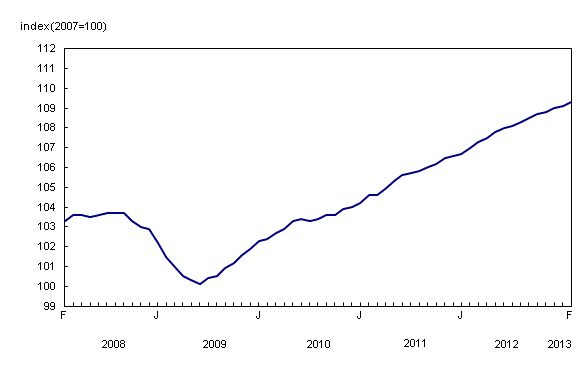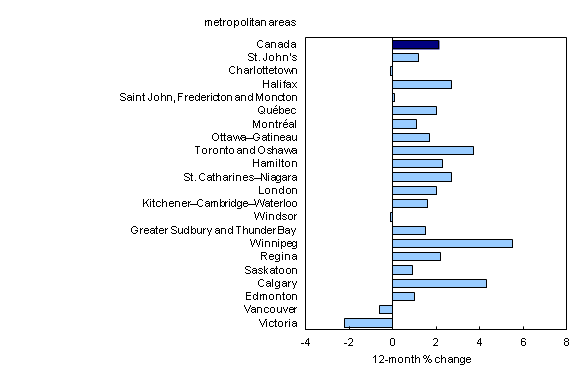New Housing Price Index, February 2013
Archived Content
Information identified as archived is provided for reference, research or recordkeeping purposes. It is not subject to the Government of Canada Web Standards and has not been altered or updated since it was archived. Please "contact us" to request a format other than those available.
Released: 2013-04-11
The New Housing Price Index (NHPI) rose 0.2% in February, following a 0.1% increase in January, and similar increases over the second half of 2012.
Calgary was the top contributor to the advance in February, up 1.0% from January. This was the largest month-over-month increase in that region since May 2007. Builders indicated that increases in material and labour costs were the main reasons for higher prices.
The largest monthly price advance in February occurred in Regina (+1.4%), where builders reported increased operating costs and a shortage of developed land. In Halifax, prices rose 0.9% from January, with builders citing higher costs for materials, labour and developed land as the primary reasons. These price increases were the largest for both regions since February 2012.
New housing prices declined 0.2% in Ottawa–Gatineau for the second month in a row, while prices decreased 0.1% in St. John's. Builders cited market conditions as the reason for reduced prices in both regions.
In February, prices were unchanged in the combined metropolitan region of Toronto and Oshawa following six consecutive months of increases. Prices were also unchanged in eight other metropolitan regions surveyed.
On a year-over-year basis, the NHPI rose 2.1% in the 12 months to February, following a 2.2% increase in the previous month.
The main contributor to the advance was the combined metropolitan region of Toronto and Oshawa, where the year-over-year increase in the contractors' selling prices was 3.7% in February, compared with 5.8% over the same period in 2012. Annual price increases in this region have been decelerating since October 2012, despite a slight acceleration in January.
For the third consecutive month, Winnipeg recorded the largest year-over-year price movement in Canada. Prices were up 5.5% compared with February 2012; however, this increase was down slightly from the 5.9% annual rise observed in January. The advance was largely due to the increased cost of developed land in this metropolitan area.
In Calgary, annual prices rose 4.3% and have been accelerating for the past five months. Other significant year-over-year increases occurred in St. Catharines-Niagara and in Halifax (both up 2.7%).
Among the 21 metropolitan regions surveyed, 4 posted 12-month price declines in February. The largest annual decreases continued to be in British Columbia, where new housing prices in Victoria were down 2.2% and prices in Vancouver declined 0.6%. Vancouver and Victoria have not seen annual increases in new home prices since September 2011 and September 2008, respectively.
Note to readers
The New Housing Price Index measures changes over time in the selling prices of new residential houses agreed upon between the contractor and the buyer at the time of the signing of the contract. It is designed to measure the changes in the selling prices of new houses where detailed specifications pertaining to each house remain the same between two consecutive periods. The prices collected from builders and included in the index are market selling prices less value added taxes, such as the Federal Goods and Services Tax (GST) or the Harmonized Sales Tax (HST).
The provincial government of British Columbia introduced legislation on May 14, 2012, announcing the return to a provincial sales tax on April 1, 2013. From April 1, 2012, until March 31, 2013, there are new housing transitional rebates in place. After the transition is complete, the provincial sales tax on building materials in British Columbia will be embedded in contractors' selling prices of new houses. These changes will be reflected in the New Housing Price Index as reported by respondents.
Effective April 1, 2013, in Prince Edward Island, the federal 5% GST is combined with a reduced 9% provincial tax to create a single 14% HST. Previously, only the GST (5%) was applied to new homes. Under the new rules, the tax applied to the purchase of a new home will be 14%.
The indexes are not subject to revision and are not seasonally adjusted.
The fourth quarter 2012 issue of Capital Expenditure Price Statistics (Catalogue number62-007-X) will soon be available.
The New Housing Price Index for March will be released on May 9.
Contact information
For more information, or to enquire about the concepts, methods or data quality of this release, contact us (toll-free 1-800-263-1136; infostats@statcan.gc.ca) or Media Relations (613-951-4636; statcan.mediahotline-ligneinfomedias.statcan@canada.ca).
- Date modified:



